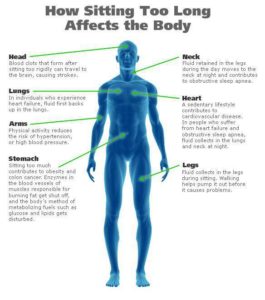A family of five in the UK recently escaped tragedy after returning home to find a fire raging in their bathroom, the UK Daily Mail reported this week. The blaze began after sunlight reflected from a shaving mirror set some towels alight.
A spokesman for the local Fire and Rescue service advised householders to think about the positioning of magnifying mirrors in relation to windows, and to consider any possible fire hazards that could be caused by the sun being reflected by these mirrors.
Can I Come Too?

Funny iPhone Pic of Your Child

Stuck In Phone
A reminder that we are trying to free their minds from enslavement!
Celebrate today’s 200th anniversary of the birth of Australia’s greatest poet, Charles Harpur
With clowns to make our laws, and knaves
To rule us as of old,
In vain our soil is rich, in vain
‘Tis seamed with virgin gold!
But the present only yields us nought,
The future only lours,
Till we have a braver Manhood
In this Southern Land of Ours.
>From This Southern Land of Ours, by Charles Harpur (23 January 1813 – 10 June 1868)
Charles Harpur, Australia’s first national poet, but also philosopher, patriot, political activist and prophet, was born the second son of convict parents 200 years ago today on 23 January 2013 at Windsor on the Hawkesbury River.
Despite no mention of his bicentennial birthday on that supposed font of all knowledge, the internet, Harpur’s extraordinary and substantial collection of poetry, prose and philosophical writings are as pertinent and perhaps even more compelling today than they were when first published in the literary journals of the 19th century.
Given the proximity of his 200th birthday to the celebration of Australia Day, and that most Australians have no knowledge of this amazing forefather who felt called to be “the Bard of thy Country”, the CEC today pays tribute to Harpur’s life and legacy by introducing him to you, his fellow Australians.
In the mid-1800s Harpur and his poetry were synonymous with Australia coming of age and demanding its freedom and independence from the British Empire. In July 1826, the British sycophants at The Monitor newspaper in Sydney had written: “The people of New South Wales are a poor grovelling race… the scourge and the fetters and the dungeon and the Australian inquisition have reduced them to a level with the negro—they are no longer Britons, but Australians!” And a week later it reiterated that “they have lost their English spirit and have degenerated into Australians.”
Harpur was proud to be one such “degenerate Australian”, who like Robert Burns and other poets he greatly admired, including Shakespeare, Shelley, Keats and Poe, rejected the system of Empire and government of, for and by the oligarchs, in favour of the Republican ideal, that the common man had the potential to participate in his nation’s destiny, that he was the equal of the so-called upper classes and indeed that he was individually responsible for the future course of the nation.
Harpur also shared the vision of “freedom and independence for the golden lands of Australia” of the staunch republican Rev. Dr. John Dunmore Lang, saying of himself: “I am not only a democratic Republican in theory, but by every feeling of my nature. Its first principles lie rudimentally in the moral elements of my being, ready to flower forth and bear their proper fruit. Hence, as I hold myself, on the ground of God’s humanity, to be politically superior to no fellow being, so, on the same ground, I can feel myself inferior to none…”
Harpur maintained in fact that “the prime object of Society is, or should be, the perfection of Man” and all his important writings from early youth on, attempted, in one form or other, to nurture his fellow citizens’ “thinking power” as exemplified in the following stanza from his poem, Finality: “Why pile we stone on stone, to raise Jail, Fane, or Public Hall;—why plan Fortress or Tower for future days; Yet leave unbuilt, to wrong or guilt, The nobler pile—the Mind of Man.”
It worried Harpur deeply that “people are actually in danger of dying in their nobler part of sheer forgetfulness and want of mental stimuli” and he elaborated what he believed should be the aims and responsibilities of the true poet: “Her true vocation is at once to quicken, exalt and purify our nobler and more exquisite passions; and by informing the imagination with wisdom—suggesting beauty, both to enlarge and recompense our capacities of pathetic feeling and intellectual enjoyment, and further, in national and social regards, to illustrate whatever is virtuous in design, and glorify all that is noble in action; taking occasion also, at the same time, to pour the lightning of indignation upon everything that is mean and cowardly in the people, or tyrannical and corrupt in their rulers.”
Few Australian writers and poets of Harpur’s time, or since, could claim to have risen to his ideal. However, despite much disappointment in this regard, Harpur never relinquished his hope that one day, his vision of having a “nobler Manhood in this Southern Land of ours”, would be realised. He wrote: “At this moment I am a wanderer and a vagabond upon the face of my native Land—after having written upon its evergreen beauty strains of feeling and imagination which, I believe, ‘men will not willingly let die.’ But my countrymen, and the world, will yet know me better. I doubt not, indeed, but that I shall yet be held in honour both by them and by it.”
All Australians owe it to themselves as citizens, and to the memory of this great poet, to grant Harpur’s long-awaited hope by reading a selection of his truly beautiful and profound poetry on this day.
Click here to read more on the life and work of Charles Harpur.
Click herez for a selection of Charles Harpur’s poems.
To read more about Charles Harpur and the republican impulse in Australian history, click here for a free copy of the CEC’s pamphlet, From the First Fleet to the Year 2000: The Fight for an Australian Republic.
Loneliness, like chronic stress, taxes the immune system
New research links loneliness to a number of dysfunctional immune responses, suggesting that being lonely has the potential to harm overall health.
http://www.sciencedaily.com/releases/2013/01/130119185019.htm
Studies Show Calcium and Magnesium Help Sleep, Bones, Heart, Stomach, Muscles, Menopause, Migraines, Diabetes and More
Studies Show Calcium and Magnesium Help Sleep, Bones, Heart, Stomach, Muscles,
Calcium and magnesium are the most famous of all the minerals due to their vast array of benefits to our health. Dr. Linus Pauling, the two-time Nobel Prize winner said: “You can trace every sickness, every disease, and every ailment to a mineral deficiency.” Studies have proven calcium to increase bone health, reduce high blood pressure, relax the nerves and muscles, and prevent colon cancer and kidney stones. Magnesium is an effective nutrient for strengthening heart health, reducing diabetes, and treating migraines, insomnia and depression.
Calcium and magnesium were discovered by the British chemist Sir Humphry Davy in the early 1800’s. Regarding stomach and colon health, a 2007 study in the Journal of the National Cancer Institute found that calcium protects high-risk people from developing the polyps (growths in the colon) that can lead to cancer in the large bowel. The researchers found that the risk reduction occurred during the study and also lasted a full five years after the calcium supplementation ended.
Calcium supplements were shown to help prevent kidney stones in a 2008 study at the University of Wisconsin School of Medicine. The theory of how this works is that dietary calcium binds with a waste product in the stomach called oxalate, which comes from foods like spinach, strawberries, nuts and tea. Most kidney stones are made of oxalate. When calcium is taken, the calcium and oxalate bind together, crystallize, and exit the body long before there’s a chance for the oxalate to form into kidney stones.
Mildred Seelig, M.D., the leading medical researcher on magnesium says: “Many people needlessly suffer pain – including fibromyalgia, migraines and muscle cramps – because they don’t get enough magnesium.” According to the University of Maryland Medical Center, inadequate magnesium also appears to reduce serotonin levels in the brain. One study found that magnesium was just as effective as an antidepressant drug in treating depression. In addition, researchers at Stockholm’s Karolinska Institute reported that for every 100 milligram increase in magnesium intake, the risk of developing type-2 diabetes decreased by 15 per cent.
Studies have found that people with migraine headaches have low concentrations of magnesium in their body. The word “cephalalgia” literally means head pain or headache. In a German study of 81 migraine patients published in the journal “Cephalalgia”, 42 percent of the people taking oral magnesium reduced both the duration and intensity of their migraine attacks. They also reduced their reliance on medications to control migraines.
James F. Balch, M.D., author of Prescription for Nutritional Healing, writes: “A lack of the nutrients calcium and magnesium will cause you to wake up after a few hours and not be able to return to sleep.” Chronic insomnia is one of the main symptoms of magnesium deficiency. Sleep in magnesium deficiency is usually agitated with frequent nighttime awakenings. On the other hand, a high magnesium diet has been found to be associated with deeper, less interrupted sleep. This was shown in a study done by James Penland at the Human Nutrition Research Center in North Dakota.
Nutritional supplements containing highly absorbable forms of calcium and magnesium can double as an effective sleep remedy. An example of a well-balanced mineral supplement is Sleep Minerals II from http://www.NutritionBreakthroughs.com. This natural insomnia remedy also includes vitamin D and zinc and is delivered in a softgel form with healthy carrier oils, making it more quickly assimilated than tablets or capsules and providing a deeper, longer-lasting sleep.
Kimberly B. of Troy Michigan says: “I have been taking Sleep Minerals II for about a month now. I have tried everything out there and this supplement is amazing. I have suffered with insomnia for two and a half years and have had restless leg syndrome my entire life. This is the first relief I’ve ever had…it’s gone for a month now.”
The best thing about supplementing with calcium and magnesium is the large list of studies showing they support virtually every part, organ and system in our body.
For more information on Sleep Minerals II visit http://www.nutritionbreakthroughs.com/html/sleep_remedy_for_insomnia_help.html
How Sitting Affects The Body
60 Lab Studies Now Confirm Cancer Link to a Vaccine You Probably Had as a Child
 The HPV vaccine Gardasil, which is being vigorously pushed on unsuspecting young girls and women to theoretically guard against cervical cancer still has never been proven to actually prevent cancer. On the contrary, evidence suggests that under certain circumstances the vaccine increases your risk of precancerous lesions by nearly 45 percent, and an ever increasing number of girls are being seriously injured by this unnecessary vaccine.
The HPV vaccine Gardasil, which is being vigorously pushed on unsuspecting young girls and women to theoretically guard against cervical cancer still has never been proven to actually prevent cancer. On the contrary, evidence suggests that under certain circumstances the vaccine increases your risk of precancerous lesions by nearly 45 percent, and an ever increasing number of girls are being seriously injured by this unnecessary vaccine.
As of December 13, 2010, 20,915 adverse reactions had been reported in the United States alone, including 89 deaths, 297 miscarriages or stillbirths, and 370 reports of abnormal pap smears post vaccination.
All of this from a vaccine that has only been on the market for four years!
Making matters worse, as of 2009 the US FDA approved Gardasil for use on young boys as well, and the first male death has also been reported. In September of last year, a young boy died just eight days after being vaccinated with Gardasil.
Regulators Discover a Hidden Viral Gene in Commercial GMO Crops
In the course of analysis to identify potential allergens in GMO crops, the European Food Safety Authority (EFSA) has belatedly discovered that the most common genetic regulatory sequence in commercial GMOs also encodes a significant fragment of a viral gene (Podevin and du Jardin 2012). This finding has serious ramifications for crop biotechnology and its regulation, but possibly even greater ones for consumers and farmers. This is because there are clear indications that this viral gene (called Gene VI) might not be safe for human consumption. It also may disturb the normal functioning of crops, including their natural pest resistance.
What Podevin and du Jardin discovered is that of the 86 different transgenic events (unique insertions of foreign DNA) commercialized to-date in the United States 54 contain portions of Gene VI within them. They include any with a widely used gene regulatory sequence called the CaMV 35S promoter (from the cauliflower mosaic virus; CaMV). Among the affected transgenic events are some of the most widely grown GMOs, including Roundup Ready soybeans (40-3-2) and MON810 maize. They include the controversial NK603 maize recently reported as causing tumors in rats (Seralini et al. 2012).
The researchers themselves concluded that the presence of segments of Gene VI “might result in unintended phenotypic changes”. They reached this conclusion because similar fragments of Gene VI have already been shown to be active on their own (e.g. De Tapia et al. 1993). In other words, the EFSA researchers were unable to rule out a hazard to public health or the environment.
http://independentsciencenews.org/commentaries/regulators-discover-a-hidden-viral-gene-in-commercial-gmo-crops/


